|
| |
- This page contains pictures and information about the Austral
Ellipsidion Cockroaches that we found in the Brisbane area, Queensland, Australia.
-
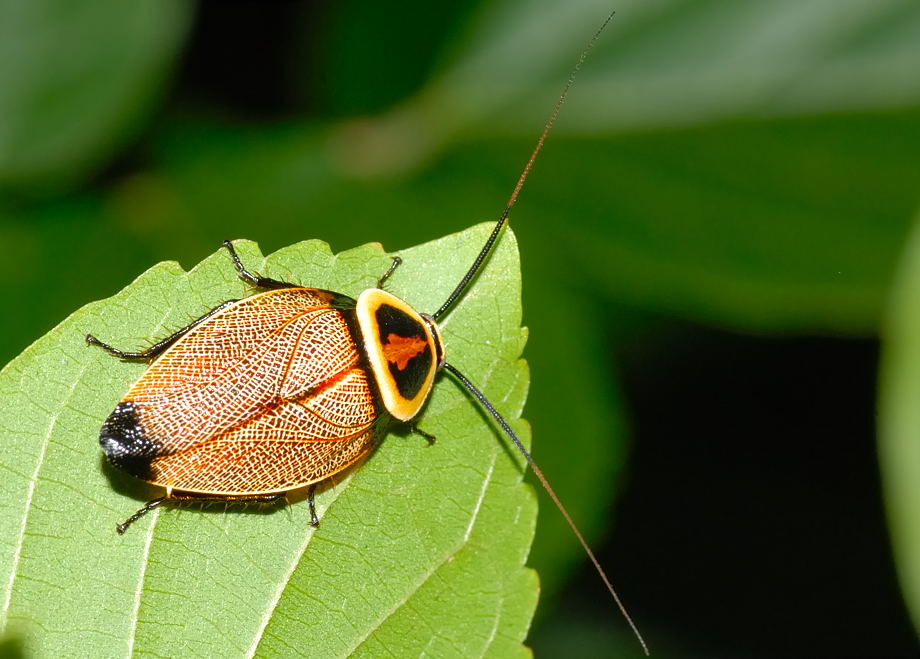 - Body length 18mm
-
- Not all cockroaches are ugly. This Austral Ellipsidion Cockroach looks beautiful. Its body
is orange-brown to dark brown with white patterns. Its thorax is dark brown
with a good looking yellow around the edge. The cockroach adult is winged, with
brown forewings covered the black and white abdomen. Male and female look
almost the same. Nymphs have the similar body structure except wingless.
-
- Austral Ellipsidion Cockroaches are common in Brisbane. We found them all year round
here.
-
 
 -
- Cockroaches are classified in order Blattodea. Most of them are
beautiful insects although this perception is always outweighed by their name
"cockroaches". They have long spiny legs, their antennae are longer than their body.
The body is usually flat
and broad so that they can squeeze into very tight gaps. The head is small and
pointing downwards, concealed under the pronotum.
-
-


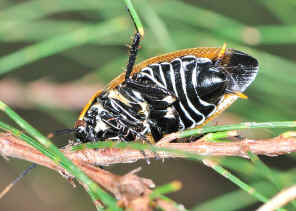
- They are very
good runners. This Cockroach is active at day time, running openly on the
leaves and flowers. Most other cockroaches
are scavengers, they feed on almost everything. We are not exactly sure what
this Austral Ellipsidion Cockroach feeds on, but they are always found on plants, seldom on the
ground.
They are believed feeding on pollen, honeydew and mould fungus.
Cockroach Reproduction Cycle
- Cockroach adults find their parts for mating. Mating preceded by courtship
involving male and female pheromones. Copulating pairs remain joined for some
time. The above photos were taken in mid summer. However, we believe the Austral Ellipsidion Cockroaches may not have the particular mating season. Mating
can be seen any time of the year.
-


 - Mating
-
- Austral Ellipsidion female produces groups of eggs enclosed together in a
single capsules called o÷thecae. The o÷thecae sometime seen attached to the
end of the female abdomen. O÷theca is a pale, soft egg-sac that hardens when
exposed to air. The ovipositor valves serve as a mould that forms the o÷theca.
Each egg is in a shell surrounded by an air space. The O÷theca is carried for
some time before it is deposited. They are usually attached on leaves or
stems.
-


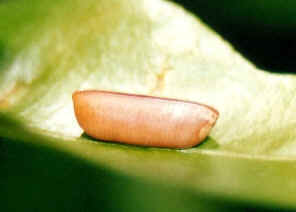 - O÷theca
-
- In spring season, we found the above
female cockroach with ootheca. There was another ootheca
found near-by. We took the ootheca home and tens of small cockroaches hatched after one week. They were dark brown in colour with 1.5mm body length.
-
 
 - Young nymph, body length 8mm
-
 

- Young instars
-
- We found that they grow very slowly, could be one generation per
year. However, different stages of instars can be seen at the same of the year. Cockroaches
develop in in-complete metamorphosis.
-

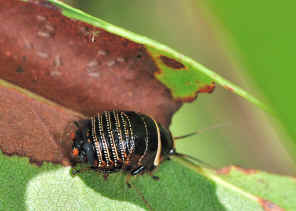
 -
-



-



- Moulting
-


 - Medium size instars
-
-

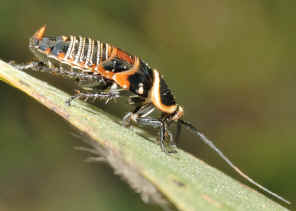

- Large
instars
-


 - Last instars, body length 18mm
-


 - Last Instars, body length 18mm
Last moulting
-
- The above photos show the last instars stage nymph. The second picture
shows it became an adult after last moulting.
-
 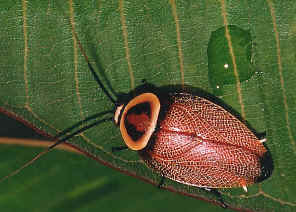
 -
- The photos show the winged adult wandering in bush. Although most cockroaches are active at night,
the Austral Ellipsidion Cockroaches forage on foliage of shrubs during the daytime. They run
away very fast when disturbed. They can be found in our backyards and
bushlands in Brisbane.
- However, the Austral Ellipsidion Cockroaches never found inside houses. They always look beautiful and
clean.
-
-
 

-
- Reference:
- 1. Insects
of Australia - CSIRO, Division of Entomology, Melbourne University
Press, 2nd Edition 1991, Fig.19.8H,I.
- 2. Grasshopper
Country - the Abundant Orthopteroid Insects of Australia, D Rentz,
UNSW Press, 1996, plate365, p230.
Back to Top
[ Up ] [ Austral Ellipsidion Cockroach ] [ Small Ellipsidion ] [ See-through Ellipsidion ] [ Beautiful Ellipsidion ] [ Balta Cockroach I ] [ Balta Cockroach II ] [ Balta Cockroach III ] [ Orange-brown Bush Cockroach ] [ Shelford's Cockroach ]
| |
|














































